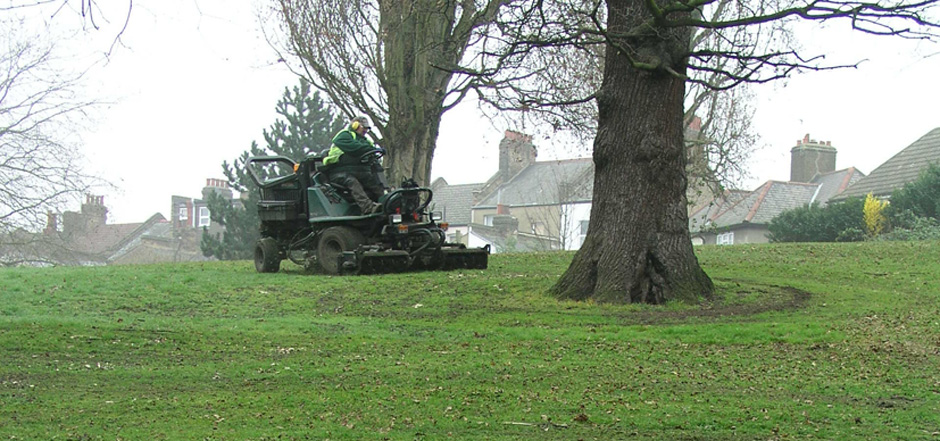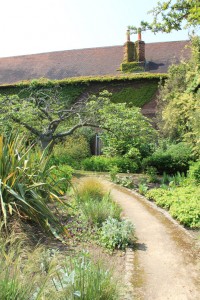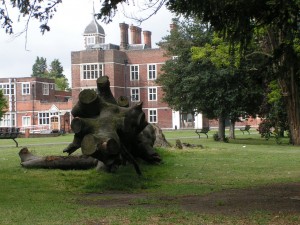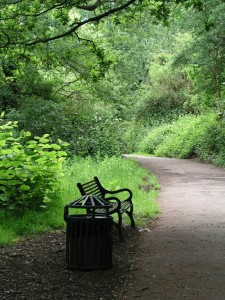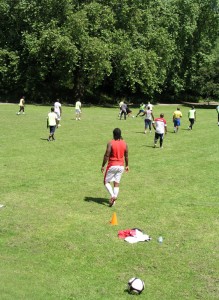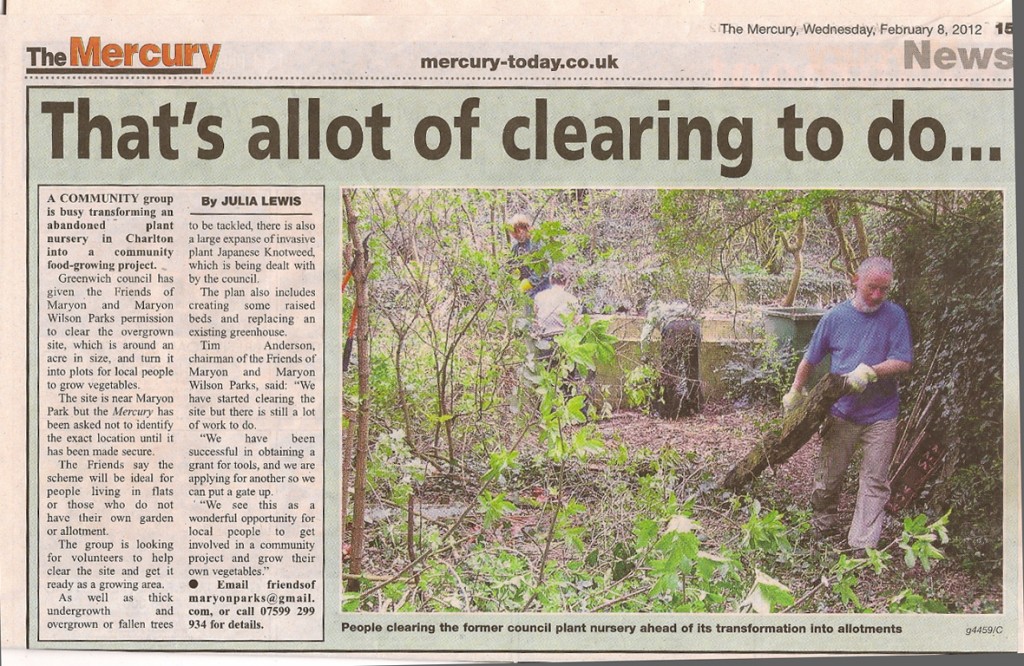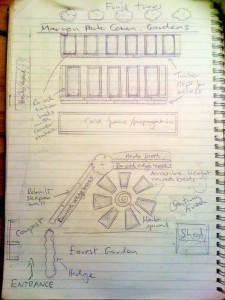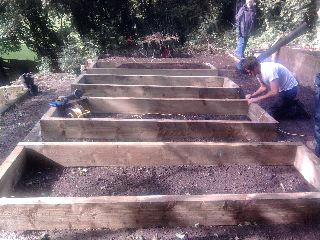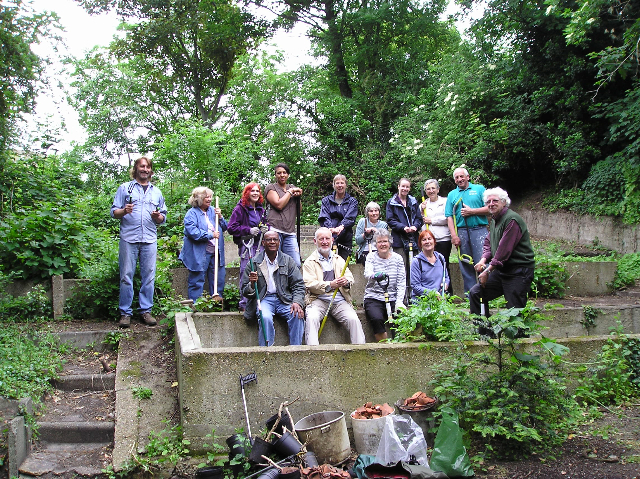Area of Interest
Developments in the parks
Extract from Interview Transcript: Lee Beasley talks about developments in Charlton Park.
Really in the time I’ve been associated with the park [CharltonPark], which is thirty years or so, it hasn’t really changed much. It really hasn’t changed much. Generally it’s dominated by sport at the top end and it’s fairly ornamental. I suppose one big change was the introduction of the herbaceous gardens to the back of the house. The secret garden at the back of the house, when that was refurbished a few years ago and a gravel path was… about seven or eight years ago the gardens to the rear of the house were re-landscaped. York stone paving, gravel paths and herbaceous perennials, mainly, planted to create a secret garden kind of effect and that’s very successful.
The herbaceous borders and the long beech hedge is a classic historical feature of the rear of the house gardens. It’s predominantly made up of sort of typical Victorian planted trees, old oak particularly to the left looking down the field from the house. Chestnut, beech… and where we have had some large trees fallen in the last few years – recently we had a chestnut and a beech go over in the last five years – and on both of those occasions we’ve actually left the trunks in situ for habitat creation and just general natural play and they’ve been very well received. They just need the minimum of management to make sure they’ve safe otherwise we tend to adopt that kind of policy. I think that’s something we wouldn’t have done twenty years ago and that’s definitely a change in parks management, you know, as a general rule to encourage bio-diversity and allow natural habitats to develop where we can.
So that’s perhaps one of the changes across a number of parks. Not so much in Charlton Park. It doesn’t sort of lend itself to that kind of management in many ways because it’s so sport on one end and so very formally managed in relation to the house at the other end so we try to retain those sort of historical characteristics and to introduce a meadow or woodland planting in that park would compromise perhaps some of the historical management features. So it doesn’t lend itself… but where we can we do and leaving dead, standing timber or even dead, fallen timber if it’s safe is something we’ll do.
You’ve done that in Maryon Wilson.
Yeah, Maryon Wilson… lots, lots of encroachment of grasslands has been allowed and the woodlands has been allowed to just move around a little bit and develop so we’ve got sort of mature woodland and maturing woodland and then the grasslands – quality grasslands as well – but those kinds of sites lend themselves to it, perhaps, a little bit more than…Charlton Park’s very formal. It’s surrounded by a road – roads – it’s sort of contained in a way and because of the sport the grass needs to be maintained as amenity grassland. And, obviously, because of the house at the other end it really needs to be maintained in some sort of traditional way, as a Jacobean…
Yes, the house is Jacobean.
Jacobean style and that would be sort of formal bedding displays and the floral shield and those kinds of… rose gardens and that kind of…
When did those shield plantings come in?
I don’t know. They’ve certainly been there for more than thirty years and we’ve only got two in the borough. The other one’s in Well Hall Pleasance. Shield planting is old but not hundreds and hundreds of years old but it’s certainly a hundred or so plus years and it used to traditionally be a clock that would go in in a town just as an ornamental feature. It serves no other purpose. But it’s a very sort of specialised planting technique involving… in Well Hall Pleasance and not perhaps to the same degree in Charlton House because it’s a smaller shield… in Well Hall Pleasance I’ve personally planted that shield up many times and thirteen thousand plants have gone in in one display… just on a shield, you know. I’ve not personally planted the shield at Charlton House but certainly I would suggest more in extent of ten thousand plants would have gone in there for a display.
Is that to get the density of colour?
Yeah. Well it’s because the plants need to be small and compact and are specialised and have to be grown to spec and grown to size. It limits the number and types of plants one can use so they need to be instant so when they’re planted up in July… or June ideally… they’ve only got three or four months of show and they need to look grown. We don’t want plants that are rapidly going to grow so we put plants in that are already grown into the size and we actually order them in sizes so two inch plants… French plants… that’ll be the circumference or the diameter of the plants… when they’re growing them. And they’re limited on the… you know, they need to be a dwarf habit as well. So it’s quite a specialist thing, floral shields.
In relation to both of those shields in Greenwich there’s no commercial aspect to it. We simply put it out to the communities and encourage invitation to represent societies and organisations and, typically, we would receive proposals from Girl Guides or the Guide Dogs for the Blind Association… local organisations or a club and, providing their logo or their emblem or their badge can be simplified, because usually there’s too much detail… providing it can be simplified we would simplify the design and then plot it up. There’s no charge to anybody. It’s all picked up as… traditionally anyway… it’s always been picked up by the council as a public display.
Extract from Interview Transcript: Paul Martin comments on relatively recent changes in use of Maryon Park
(An edited audio version of this extract may also be heard below.) Has it changed how it’s used? I’ve been here twelve years now. There’s been more of an influx of migrants into the area so over the weekends… in the summer… it’s become more multi-cultural. There’s much more eastern European families and Africans. So I’ve seen that really increase, which is lovely. Different cultures using the park, particularly of a weekend. I’ve seen that, you know. The anti-social behaviour I’ve managed to… I can manage, you know. I can manage that, you know.Do they use the park in a different way… east European and African people?
They’re absolutely fine. Do they use the park in a different way? Eastern European is predominantly male and it’s football, football-based. But it’s quite intimidating actually because on a Saturday or a Sunday, when the weather’s really nice, there could be as many as – I took some pictures to show my old manager – I bet there’s as many as eighty, I think I counted eighty males all around the bottom green there. So it’s quite intimidating but they’re absolutely fine. I’ve seen a couple of punch-ups amongst them but they sort that out themselves. But they’re mainly focused around football. And they’re very respectful towards me. I can’t say I’ve had any problems with them. There’s different religions as well. Muslims and Asian families using the park more which is great. It’s a real multi-cultural setting in the summer… ethnic backgrounds, you know. It’s lovely.
Audio Extract: Paul Martin talks about relatively recent changes in use of Maryon Park
Extract from Interview Transcript: Paul Martin describes living in Maryon Park Lodge
(An edited audio version of this extract may also be heard below.)How living in the park has affected my day-to-day life? It’s been a great experience for me and my family I must admit but, you know, it does come with its shortcomings. I mean, I’m the sort of focal point in the community in some ways, living in the park house. If anything goes on inside the park then, obviously, they’ll come and knock on my door so, particularly if I’m on annual leave, I’m having a rest from work, I’ll still have to respond to people knocking. It could be the police, members of the public. In the summer you get children that have been injured in the park, scraped their knees and want First Aid. Different issues really. You’re sort of like the focal point, you know. Motorbikes, anti-social behaviour… people will come to me. They will knock on the door. You know, “What are you doing about these motorbikes?” And so there’s good and bad aspects, I suppose, but mainly, on the whole, it’s a great experience I must admit.
My daughter’s eight now. She was born in that lodge. It’s been absolutely brilliant. She’s so lucky and she knows it as well, even at a young age. She is so fortunate to be living in that house in that environment. I often say to her, ‘How many of your friends in your class have got a park outside the front door?’ It’s amazing. It’s crazy. We was out on Sunday building a snowman in the park, you know, just engaging with all the people. It’s fantastic really. She’s so lucky. I am – we are as a family – very, very lucky. The negative aspects that come with living in the lodge, really, you know, don’t outweigh the positives, you know what I mean? Really, really lucky.
I’ve said to her when she’s older, when she’s an adult, that house should still be there and she’ll be able to come and pop round with her friends and say that’s where… that was my first house. ‘You know, that’s where I grew up.” And I think that’s a wonderful experience.
Audio Extract: Paul Martin talks about living in Maryon Park Lodge
Extract from Interview Transcript: Tony Dyson, talking with Rose Savinson and interviewer Carol Kenna, is sceptical about the Council
Rose: They used to sort of open up Gilbert’s Pit. We went into that bottom bit of Gilbert’s Pit that you get to offPoundParkand had these enormous community rounders matches. Everyone used to go down there with picnic – food and drink – and have these huge rounders games, down in Gilbert’s Pit. We did that several years running. I can’t remember how many but, you know, that was a really, really nice thing to do.
Tony: Yeah, but do you see what it’s like now? You won’t have any rounders games down there now.
Rose: No, it’s all overgrown again.
Tony: It’s completely – the grass is up to here! It’s all being encroached on.
It’s the new way of looking after the parks, isn’t it? To let a lot of it go wild.
Tony: I think it’s a great big excuse so as not to have to do it. I really, really do think that. I think there’s plenty of wild down there but this where the rounders used to take place is a nice little sort of oval shaped, flat bit of ground. A brilliant place for that kind of thing and there’s still loads of places for animals to be wild and birds to flourish and insects and everything else. All round there but, I think that’s a great big excuse by the council to not to have to bother to cut it anymore. They say, ‘We’re returning it to nature.’ I really do think there’s no need…
We could raise it a Friend’s Meeting.
Tony: I used to be chairman of the Friend’s Meeting once upon a time and I resigned, in the end, out of sheer… I got fed up with the sort of half-truths and evasions that you used to get from the council about, ‘We really care about the parks,’ and all this stuff and quite clearly they’d… Bit by bit the brambles have been coming back. I could produce photographs that we took when we first moved down here and it is so different now. There’s so much been reclaimed by nature. I don’t think it’s got anything to do with allowing nature back in, you know. I just reject that argument totally. I think it’s an excuse not to have to do it anymore. I think it’s really disappointing.
Is that your moan or would you like to go into your moan now?
Tony: Well, this is my moan… yes. And I would just extend that to… if you walk down through the deer park, pass the deer on the right-hand side and the ducks on the left-hand side, if you’re coming from this end, there used to be a lovely triangle there where azaleas used to grow in the spring and it was very pretty and there were rhododendrons behind them and that’s been allowed to go. And I really think, even with cutting back staff and everything, it doesn’t take much just to keep that lovely little triangle going. It’s beautiful in the spring and now that’s overtaken by brambles. Nobody’s done anything. I think it’s… I just got disillusioned and I don’t go in the park anymore. I used to love that park. I don’t have any dogs. I’ve got through two dogs now. I’m not allowed to have another one but, even if I did, I wouldn’t go in the park because I’m just depressed by…
Rose: That’s very sad.
Tony: Yes, I am. It is.
Rose: Because the park is still amazing.
Tony: The park… it’s amazing and anybody coming into the area, walking there, would probably think, ‘This is a fantastic park.’
Rose: I try to get in there virtually every day.
Tony: Remember what it used to be like and I think it’s…
Rose: There’s still a lot…
You might be heartened to know that one of the park department people also saw that triangle that you’re talking about and was equally depressed by the way it had been treated.
Tony: Yeah. Are they going to do something about it?
That I don’t know.
Tony: I would happily get involved with three or four other people and do it but they don’t want you to do it. You know, you’d have to apply to somebody and go to all the bureaucratic…
Start up your own parks movement. Go round planting things.
Tony: Just go round planting but before you plant them you’ve got to get the brambles out because the brambles have now taken over in that triangle and brambles are not something you just dig up overnight otherwise I would happily do that. But then they’d probably just come down and dig them out again out of sheer cussedness because you hadn’t gone through the right channels to get permission to do it, you know.
You could try.
Tony: You could try.
Anything’s worth the try, isn’t it?
Tony: Yeah. It does depress me and I don’t go in the park now really.
Rose: I was going to say near that triangle – the azalea triangle – the thing I used to like was the fact that there were toilets there.
Well, you had everything, didn’t you. If you were out there with your children you could stay there for a long time, including the children. The children could stay there for a long time because they had everything they needed apart from food. You didn’t have all this plastic being thrown around the place because they had drinking fountains. That’s my big beef, the loss of the fountain.
Tony: Yeah, absolutely. I still love the area.MaryonPark, I think is still a lovely park. It’s got a lovely sort of bowl shape to it and I think it’s very attractive and Oxley’s Wood. I could go Oxley’s Wood any time and Greenwich Park… beautiful, but I’m afraid Maryon Wilson Park… it just depresses me to go there so I just tend not to unless I’ve got to for some reason. Well, if I’m walking to Charlton one day and I just want to cut the corners off I’ll go through the park. It doesn’t give me the pleasure it used to give me, sadly.
Rose: That’s a shame.
Tony: It is a shame. It’s a great shame.
Rose: I think it gives me as much pleasure as it always did. And all the time until the early nineties I was much more connected with the bottom parks. That’s where we lived. I spent all my time inMaryonParkand it was only when we moved to the top road that I sort of discovered Maryon Wilson so I didn’t really have memories from…
Tony: Well, I think your heart is inMaryonParkand my heart is in Maryon Wilson Park and my heart’s been broken. Yours has not been because –
Rose: I still delight in Maryon Wilson Park. I sort of deliberately take myself in there whenever I can, whenever I can think of any excuse to go for a walk in the park and I’ll do it.
Maryon Park Food Growing Project
The Maryon Park Community Food Growing Project
When Maryon Park was the responsibility of the London County Council, the LCC established a plant nursery that grew flowers for planting out in the council’s parks and open spaces, hidden away from the general public. The nursery, on the south side of the park, had a greenhouse, compost areas and terraced cloches.
In 2008 at when the Maryon Park Development Plan in 2008 was being developed, Greenwich council, now responsible for Maryon Park, suggested that the now disused nursery might become a community garden.
In April 2011, local artist and local resident Mickey Dell, suggested that the Friends of Maryon and Maryon Wilson Parks took over part of the site to establish a community food-growing project.
Abandoned for 25 years, the site was extensively overgrown, its access blocked by fallen trees. In the spring of 2011 the Friends advertised for volunteers to help clear and prepare the site. Groups of up to 20 people worked on the overgrown site. Apart from the overgrown shrubs, volunteers found that the site had also become an unofficial tip for domestic rubbish.
The Friends have since successful applied and received grants and support from Capital Growth and Groundwork Transform. Garden tools have been purchased and Transform, the Olympic green legacy fund, provided a garden designer and contractors to help prepare the Community Food Growing Garden.
By July 2012, the site is almost ready for planting and plots will soon be available for local people who want to joint the project and “Grow Their Own”. Tim Anderson, Chair of friends of Maryon and Maryon Wilson Parks.
Park Wardens
Extract from Interview Transcript: Ann Foster remembers Mrs Broom
I can remember the park mainly because we spent most of the time in the swing park, where Mrs. Broom was the lady who sat in the hut with her little cooker and she sat there all day – obviously, not every day but there would be somebody else that would take over – but, over the years that we were children, she always seemed to be there. She was very kind and we used to do things, obviously, we weren’t supposed to like making the slide greasy with candle wax so that it went faster… and it was a very, very high slide. When I think now I don’t know how we did it.
I know one day, when we was in the swing park, we found sixpence under the park bench so we gave it to Mrs. Broom. ‘Here’s a sixpence,’ because we’d been told if you handed anything in and it didn’t get claimed we’d get it back. It was me and my friend Sheila Land. So we handed it in and she gave it to the park-keeper when he came round and then we kept saying to him, “We will get that money back if no-one collects it?” And we did get this sixpence back, so we had threepence each.
Animals
Extract from Interview Transcript: Paul Tiffen describes a typical day with the animals
(An edited audio version of this extract may also be heard below)
Could you give us an outline of a typical day working with the animals in the animal park?
Well, I’d start at 7.30. We’d open up the yard, then I used to go straight into the animal centre where the small animals were kept, checking that they’re ok. Then up to the office, as it was rather poshly called, and open that up and then into the feed room. Get the feed ready for the outside animals – always fed those first because I felt that they needed feeding before the insiders because they’re out in the elements.
So, I’d go round. As I went round I would check the fencing because we’ve had problems with the fencing, people cutting the fence in the past and had incidents with dogs being put in there, unfortunately… rather sick people. So I’d go round, check the fencing, check the animals visually, feed them. Go round all the pens and making sure that everything was okay and the streams weren’t blocked and that sort of thing.
Head back up from feeding – the goats first and the deer and the sheep and then round to the ponies. With the sheep, of course, there was all the chickens and ducks and pea fowl. So, feed the ponies and up to the yard. Feed the small animals in the yard then – usually by then it was tea-break time. Takes a bit of time. It all sounds pretty quick but it all takes time to carry out these jobs.
After break it would be picking up pony poo and, perhaps, some fencing wants repairing. There’s always things that wanted doing and something wanted checking over or repairing, nailing up, whatever. Raking leaves or clearing the streams. There’s all sorts of jobs. They’re so numerous I can’t even remember them now.
That would be going up to lunch-time. After lunch-time, carry on in that same sort of vein and, middle of the afternoon, start feeding up again. Going round checking the animals, making sure the fencing’s okay. Wind up with the inside animals, feed them all up. Doing any cleaning that was necessary and that would be the end of the day. Prepare the food for the morning, of course, so that I’m ready to head out again. That’s a sort of typical day… hopefully.
What time did you finish then, usually?
4.30. 7.30 to 4.30.
Audio Extract: Paul Tiffen describes a typical day with the animals
Extract from Interview Transcript: Paul Tiffen remembers starting work
(An edited audio version of this extract may also be heard below)
Well, I started in the park. I’d been in an office for about a year. Before that I’d been repairing cycle racing, tubular tyres and doing silkscreen printing but the office – I hated the office, claustrophobic sort of atmosphere although it was a rather large one. I wanted to get out. I always preferred to be outside so I applied for a job down the bottom park,MaryonPark, just as a gardener’s assistant really. That’s all it was. And I got the job so I stayed down there for about six months and then, because I’ve always loved animals I managed to get a transfer up to the Maryon Wilson Park and when Harold, who was the stockman at the time, needed any help he called on me.
So were you trained on the job?
Yes. I was training on the job but of course, in those days, we only had ponies – or pony – depending, because it was GLC at the time, Greater London Council, and Maryon Wilson was used as a sort of halfway house, if you want to put it that way. If they wanted to house ponies for a while they’d put them there or, perhaps, there’d just be one as I say. There was just those and the sheep and the deer. That’s all there was when I went to the park.
Audio Extract: Paul Tiffen remembers starting work
Audio Extract: Paul Tiffen describes the small animals
Audio Extract: Paul Tiffen describes the ponies
Audio Extract: Paul Tiffen remembers being on call
Walks with Rangers
Audio Extract: John Beckham walks with Carol Kenna in Maryon Wilson Park
Extract From Interview Transcript: Mel Gallaghy remembers changes in Charlton Park
(An edited audio version of this extract may also be heard below)
When I first started on the parks this is one of the first parks I worked in and here we used to have seven tennis courts and a putting green. We used to have a hockey pitch here and it was very well used. And, also, you’d got the running track, which Cambridge Harriers used to train on. They’ve moved down toSutcliffeParknow. They moved about… I suppose over ten years now, so now the running track isn’t really used. None of this is used as it used to be. I can remember at school – I used to go to school down the road at St. Austin’s – and we always used to have our sports day up here. The whole school would come up and we had a proper running track but it’s all grassed over now.
Who would have used the hockey pitch?
We used to get a lot of hockey teams up here. You’d get people playing regular of a weekend and then, once a year, they used to have a big hockey festival. Used to get a lot of the Asian teams, because they’re big in hockey, the Indians, and also we’d get them from all over the country. They’d come down. It was a really big festival. It was held over two days, on a Saturday and a Sunday. And we’d have about two or three pitches and you’d get thousands of people in here coming to watch and it used to be a really good weekend.
Audio extract: Mal Gallaghy remembers changes in Charlton Park
Audio Extract: Mal Gallaghy reflects on the cult of Blow Up
Extract from Interview Transcript: Mal Gallaghy walks in Charlton Cemetery
(An edited audio version of this extract may also be heard below)
We’re now crossing Cemetery Lane, going to Charlton cemetery.
Yes. This opened about 1850, something, I think… ’55. It was mainly for gentlemen, the graveyard. You know, people who had money.
If we just come over to this one, there’s a bit of a story to this one. This was a young bride who died on her wedding day and her name was… what was her name? Gemma Airlie or something, she died about 1860 on her wedding day and down below there’s tables and chairs that the mourners used so there’s quite a big area there. And also, on the same day she died, her sister died inNorfolk. So whether they were twins… but we can’t find nothing about her. I’ve looked her up on the internet but I can’t find who she was or what, you know. They just tell us about the grave and that.
Would you like to describe the tomb that we’re standing in front of?
Yes. What would you call that? It’s big columns with a roof on it.
It’s a bit like the Greek columns.
Greek columns, yeah. You’ve got the effigy of her there, lying there in her wedding dress. And, as I said, down below they’ve put the tables and chairs. Whether that was from the wedding or what, I don’t know. Why would they put it down there? I don’t know. She must have been a wealthy family because it is a big monument.
Audio Extract: Mal Gallaghy walks in Charlton Cemetery
Audio Extract: Joe Woodcock talks about tree management
Extract from Interview Transcript: Joe Woodcock talks about working with trees
The foreman would come in and say, ‘Right we need to fell that tree’ and somebody would be given an order and they’d simply fell a tree. Nowadays people are far more conscious of their environment. They’re far more discerning for the needs of the environment and in particular, in my case, trees and so we don’t just fell trees if we see that they’ve got a brackish fungus on. At some point in my career I remember them being known as fungal diseases and probably that’s the wrong terminology. We like to think of fungal fruiting bodies living or co-existing with trees and these days we have the technology to work out which fungi are the aggressive fungi, which ones are less so and as a result of that we can decide as and when we have to carry out tree surgery work. In fact tree surgery work nowadays with, all responsible land owners, not just local authorities, is based on tree dysfunction.
When we do fell them now, as you saw across the other side, we leave them laying on the ground if we can to improve and increase biodiversity so that’s good as well and they’re quite good. I mean, you’re asking about vulnerable trees so I suppose the older ones, particularly the old Taxus baccata… the yew trees… you know, they’re possibly more vulnerable simply because of their age. They’ve such longevity.
There are all these issues about global warming nowadays so it’s very, very important to have shaded areas and dappled shaded areas in parks and gardens I feel, so it’s very important for us.
London planes. Sometimes they’re called Platanus Europaeus but you find them all over Europe but we call them, commonly, London planes, of course. But they are a fantastic tree for an urban environment because they’ve got the ability to absorb pollutants and then they shed their bark… quite a natural phenomenon… and in the winter, if you get winter sun on the bark it looks absolutely fantastic where they’ve shed that bark. And then they’ve got the large leaves that give shade and that’s why they’re particularly good in southern Europe where it can be quite warm. I was just recently in Madrid and they’ve got many of them there and wonderful to get that shade away from the midday sun. So, they’re a really good tree. The other thing about them, from our point of view… from an arboricultural point of view… is they’re made from very tough wood so some of the fungal diseases that… or fungal fruiting bodies as I should call them… that tend to affect very adversely other tree species won’t necessarily affect a London plane tree because they’ve got resistance, a really tough resistance to them. So a very, very useful tree in this environment.

